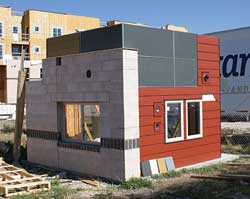Intrinsic Materials: Modernism, Sustainability and Fiber Cement Panels
The primary reason to choose fiber cement panels is because they are durable and long lasting. A fiber cement panel can be warrantied for up to fifty years. Fiber cement panels are made of wood pulp, sand, cement and water. These raw materials are typically extracted and processed near each manufacturing facility. With regards to the U.S. Green Building Council's LEED rating sytem, fiber cement panels can qualify for the use of regional materials as they are produced in numerous manufacturing plants throughout the United States.
In addition, many fiber cement products can be specified with as much as 20 percent recycled content obtaining points in both LEED, as well as in the NAHB Green Home Building rating systems when used in residential applications.
As Peter Pfeiffer, FAIA, principal of Barley + Pfeiffer Architects and designer of the first Zero-Energy home states, "Green products shouldn't be made from endangered materials. One of the reasons fiber cement products are ‘green' is because they incorporate natural ingredients that are low in toxicity. And, they last longer than other products."
Many building professionals choose this material to assist with green certification for environmental designs. However, not all benefits of a sustainable product are measured by green standards. Pfeiffer reminds professionals that "green programs are intended to provide guidelines, however, they don't account for everything - good, common sense tells you that if a product is durable, and doesn't rot, it will make your building better." Durable, longer lasting building materials require fewer resources for replacement and also reduce maintenance and repair costs.
Professionals who want to limit the emissions of volatile organic compounds (VOCs), known to have cancer causing impacts, can specify factory finishes baked on the panels to eliminate VOCs during exterior painting. They can also mandate low-VOC paints applied by the contractor.
The following shows some of the possible credits professionals can obtain when using fiber cement panels:
|
Â
Zero Waste to Landfill programs also demonstrate a manufacturer's commitment to sustainability. In the fiber cement industry, professionals can request that their product comes from a manufacturer that is committed to waste reduction by reducing the amount of raw materials that go into a landfill. In the future, professionals will be able to review new energy and water conservation programs and greater awareness of sustainable manufacturing processes in this industry.
CONSTRUCTED WALL SYSTEMS -Â Durable Weather Envelopes
External cladding and wall sections
Although a manufactured panel with a variety of unique characteristics, it is important for professionals to understand that this system is not an engineered panel system. As part of a well constructed and designed building envelope complete with a weather barrier, fiber cement resists damage from moisture both rain and snow. The possibility of moisture accumulation within the wall construction is mainly a function of the weather management design details and level of workmanship. Details such as water-resistive barrier, flashing, caulking and penetrations should be addressed on both the first (exterior cladding) and second (weather envelop) lines of defense against moisture penetration into a wall system. A high level of quality control, from design through all stages of the exterior wall construction is imperative for obtaining a wall system that weathers well and has a long life with very little repair or maintenance.
Affordable Housing with Fiber Cement Panels, |
|
The East Village Redevelopment being undertaken by The Denver Housing Authority is a $177 million dollar neighborhood revitalization project. Funded in part by a federal HOPE VI grant, the project does more than simply provide quality affordable housing close to downtown. The redevelopment knits a 6-block area into the historic fabric of the City by re-constituting several streets that had been closed off in the 1970s to create an island of clustered low-income housing. Crime-ridden and disconnected, this housing stock has been demolished to make way for pedestrian-friendly mixed income residences. The phase shown here is a $16.1 million, 89-unit apartment complex made up of two buildings. Exterior materials include CMU, primarily at the base, and a combination of fiber cement siding and fiber cement panels with expressed seams, both
pre-painted. The design team investigated a number of exterior finish systems balancing a clean aesthetic, durability, and of course cost. According to a member of the design team at |

Mock up of fiber cement panel system used at this low income housing project in Denver, Colorado. Photo courtesy of in situDESIGN |
Â
Fiber cement panel systems with expressed seams are manufactured in 4-foot by 8-foot panels of fiber cement. These panels can be ordered in many finishes and cut to fit any size of an aluminum grid. Designers cannot use these panels on the diagonal as they will encounter problems with flashing and moisture damage. Horizontal aluminum reveals are typically twelve feet long, and should be used as a continuous line from side to side of the wall system. Vertical reveals can be placed anywhere along the
wall system.









